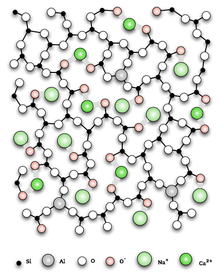Soda lime glass
Soda-lime glass , and soda-lime glass , soda lime silicate glass , soda-lime glass or normal glass is the most common type of glass and belongs to the group of alkali - alkaline earth - silicate - glasses . It is the typical bulk glass that is used to manufacture container glass and flat glass . To distinguish it more clearly from hard glass ( crystal glass ), soda-lime glass is also referred to as soft glass . It has good chemical properties and is suitable for products that usually have to withstand brief chemical stress and are not subjected to high thermal loads (e.g. pipettes, culture tubes).
Manufacture and composition
Soda -lime glass is made by melting quartz sand ( silicon dioxide ), soda ( sodium carbonate ) and lime ( calcium carbonate ) together at over 1,200 ° C. A silicate glass is formed , the main components of which are silicon dioxide (SiO 2 , 71–75%), sodium oxide (Na 2 O, 12–16%) and calcium oxide (CaO, 10–15%). In addition, other ingredients may also be included, such. B. affect the color of the glass or its sensitivity to glass corrosion . Compared to special glasses, the glass is not very resistant: acids and especially alkalis attack the surface of soda-lime glass, and even water removes small amounts of the glass components from the surface. One criterion for the chemical resistance of a soda-lime glass is the ratio of silicon dioxide to sodium oxide and calcium oxide. The composition should preferably match the formula
in which s is the number of moles of silicon dioxide and n is the molar ratio of sodium oxide to calcium oxide. The chemical structure of soda-lime glass resembles a silicate network, the bonding states of which, but not the long-range order, are comparable to the crystalline state.
properties
Soda-lime glass has a density of around 2.5 g / cm 3 .
The thermal coefficient of linear expansion of soda-lime glass is 9 · 10 −6 / K. It is therefore sensitive to temperature fluctuations. In the event of uneven heating, tensions occur in the glass, which can lead to breakage. For this reason, soda-lime glass is not used in applications with strong temperature changes (e.g. in the laboratory).
Depending on the glass thickness, the transmittance of normal glass in the visible spectrum is between approximately 80 and 90%. The thermal conductivity of soda-lime glass is 0.8–1.05 W / (m · K). The refractive index is between 1.5 and 1.6.
The mechanical properties of the glass and the products made from it must be adapted for many applications. The safety requirements in the construction and especially the automotive sector led to the development of toughened glass, an invention by the French glass company Saint-Gobain , for which a patent was applied for in 1930. This so-called safety glass bursts into a large number of small fragments when subjected to excessive stress, which are comparatively harmless.
use
Soda-lime glass is the most important type of glass in terms of quantity. It forms the basis for the production of bottles, food packaging, drinking glasses and flat glass (e.g. mirror and window glass).
Soda-lime glass is used in some areas, especially in automotive engineering, as laminated safety glass , which was invented in 1909 by the French chemist Eduard Benedictus by connecting two panes of glass with an intermediate layer of cast resin to form a glass laminate.
Individual evidence
- ↑ Alkali-alkaline-earth-silicate glasses or alkali-alkaline-earth silicate glasses for short refers to the components of these glasses : sodium (alkali metal), calcium (alkaline earth metal) and silicon (silicate); next to it oxide (oxygen).
- ↑ a b c Federal Association of the Glass Industry: Soda-lime glasses
- ^ AF Holleman , E. Wiberg , N. Wiberg : Textbook of Inorganic Chemistry . 101st edition. Walter de Gruyter, Berlin 1995, ISBN 3-11-012641-9 , p. 944.
- ↑ a b c d e A. K. Kott: On the load-bearing and residual load-bearing behavior of laminated safety glass. Dissertation, ETH Zurich 2006, pp. 7 and 13.
- ↑ Konrad Bergmeister , Johann-Dietrich Wr̲ner, Frank Fingerloos: Concrete Calendar 2009 / Part 1 and Part 2: Focus: Structural construction ... John Wiley & Sons, 2008, ISBN 3-433-01854-5 , p. 403 ( limited preview in Google Book search).
- ↑ Information on glass from the Baunetz knowledge


